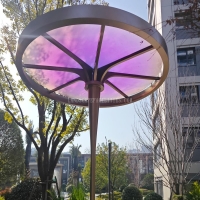Welcome to the website for landscape facilities products and knowledge.
Are there any recommended placement guidelines to ensure the table’s longevity in public spaces?
Ensuring the longevity of tables in public spaces requires careful consideration of placement strategies that address both environmental factors and usage patterns. Public tables face constant exposure to various elements and heavy usage, making proper placement crucial for their durability and functional lifespan.
The foundation of table longevity begins with strategic location assessment. Position tables away from direct drainage paths and areas prone to water accumulation. Install them on level ground with proper drainage systems to prevent water damage and structural instability. Consider the table's relationship to surrounding elements – maintain adequate clearance from walls, fences, and other structures to allow for proper air circulation and accessibility.
Environmental protection plays a significant role in table preservation. Provide adequate shade or shelter from direct sunlight, rain, and snow when possible. For outdoor installations, consider wind patterns and avoid placing tables in wind tunnels or exposed areas where they might suffer additional stress. Implement protective measures against UV radiation, which can cause fading and material degradation over time.
Material compatibility with the environment is essential. Select table materials that can withstand local weather conditions, temperature fluctuations, and humidity levels. For coastal areas, choose corrosion-resistant materials, while urban environments might require enhanced vandal-resistant features. The table's construction should match the anticipated usage intensity – high-traffic areas demand more robust materials and construction methods.
Accessibility and traffic flow significantly impact table longevity. Place tables in visible, well-lit areas to promote natural surveillance and discourage vandalism. Ensure clear pathways to tables while avoiding high-traffic corridors where accidental impacts might occur. Consider the table's purpose – dining areas require different placement than decorative or waiting area tables.
Implement regular maintenance access into your placement strategy. Leave sufficient space around tables for cleaning, repairs, and maintenance activities. Easy access encourages regular upkeep and prevents minor issues from escalating into major damage. Consider future maintenance needs when determining placement, ensuring service vehicles and equipment can reach the tables when necessary.
Proper installation techniques complement strategic placement. Use appropriate anchoring systems that suit the ground surface and environmental conditions. Follow manufacturer recommendations for installation spacing and methods. For permanent installations, ensure foundations are adequate for both the table's weight and anticipated user load.
Finally, integrate tables into comprehensive maintenance programs. Regular inspections, cleaning schedules, and prompt repairs extend table lifespan significantly. Document placement decisions and maintenance activities to inform future placement strategies and replacement cycles. By combining thoughtful placement with consistent maintenance, public spaces can maintain functional, attractive tables for years to come.
Related search:

Recommendation
Metal frame with gradient color acrylic combined with high-end shading landscape facilities